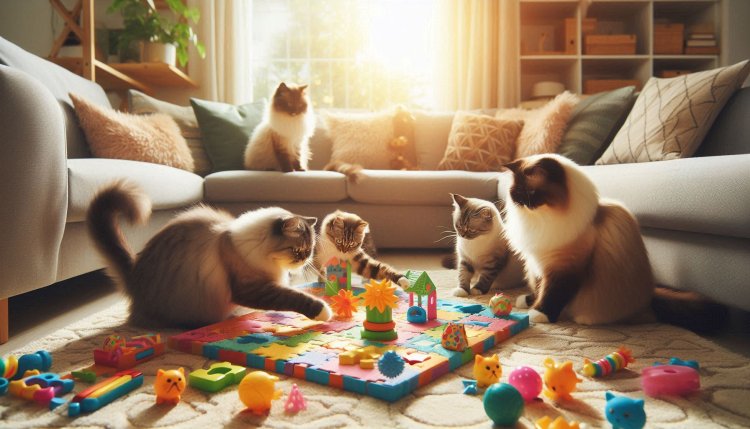Cats are natural hunters, problem-solvers, and explorers—but do they enjoy the challenge of puzzle toys and games?
Discover whether cats enjoy puzzle toys and games, the benefits of mental stimulation, and how to choose the best interactive toys for your feline friend.
Introduction
Cats are natural hunters, problem-solvers, and explorers—but do they enjoy the challenge of puzzle toys and games? As pet owners seek ways to keep their indoor cats entertained, puzzle toys have surged in popularity. This article dives into feline behavior, the science behind puzzle toys, and how these games can enrich your cat’s life.
The Benefits of Puzzle Toys for Cats
Puzzle toys aren’t just a human trend; they tap into a cat’s instinctual needs. Here’s why they’re beneficial:
-
Mental Stimulation: Indoor cats often lack opportunities to hunt or explore. Puzzle toys mimic these activities, keeping their brains active and preventing boredom.
-
Physical Exercise: Many puzzle toys require batting, pawing, or rolling, promoting healthy movement.
-
Stress Reduction: Engaging with puzzles can alleviate anxiety by redirecting energy into positive play.
-
Preventing Obesity: Food-dispensing toys slow down eating and encourage activity, helping manage weight.
Studies, such as those published in the Journal of Feline Medicine and Surgery, highlight that puzzle toys reduce destructive behaviors (like scratching furniture) by satisfying a cat’s natural instincts.
Do Cats Actually Like Puzzle Toys?
While every cat has unique preferences, most felines enjoy puzzle games when introduced properly. Cats are curious and thrive on challenges that reward their efforts—especially when treats are involved! However, patience is key. Shyer or older cats might need simpler puzzles initially.

Signs Your Cat Enjoys Puzzle Toys:
-
Persistent interaction (pawing, nudging).
-
Purring or chirping while playing.
-
Returning to the toy repeatedly.
Types of Puzzle Toys Cats Love
Not all puzzle toys are created equal. Here are styles cats tend to prefer:
-
Food-Dispensing Toys:
-
Treat Balls: Roll to release kibble.
-
Layered Puzzles: Cats slide compartments to access hidden treats.
-
Brands like Trixie and Nina Ottosson offer durable, cat-safe options.
-
-
Interactive Feeders:
-
Slow feeders with maze-like designs make mealtime a game.
-
-
Motion-Activated Toys:
-
Toys that mimic prey, like fluttering feathers or scurrying mice, trigger hunting instincts.
-
-
DIY Puzzles:
-
Cardboard boxes with holes or muffin tins hiding treats under tennis balls.
-
How to Introduce Puzzle Toys to Your Cat
-
Start Simple: Begin with easy puzzles (e.g., a treat under a cup) to build confidence.
-
Use High-Value Rewards: Entice them with their favorite treats or catnip.
-
Demonstrate the Toy: Show how it works by nudging it yourself.
-
Celebrate Success: Praise your cat when they solve the puzzle to create positive associations.
If your cat seems frustrated, simplify the puzzle or try a different style. Consistency and patience are crucial.
DIY Puzzle Toy Ideas for Cats
Save money with these creative projects:
-
Toilet Paper Roll Challenge: Fill empty rolls with treats and fold the ends.
-
Egg Carton Hunt: Place kibble in an egg carton and close the lid.
-
Muffin Tin Puzzle: Hide treats under tennis balls in a tin.
These homemade options are eco-friendly and customizable to your cat’s skill level.

FAQs About Cats and Puzzle Toys
Q: Are puzzle toys safe for cats?
A: Yes! Ensure toys are made of non-toxic materials and sized to prevent choking.
Q: My cat ignores puzzles. What now?
A: Try different reward types (e.g., wet food) or opt for motion-based toys. Some cats prefer wand toys over stationary puzzles.
Q: How often should I rotate toys?
A: Swap toys weekly to maintain novelty and prevent boredom.
Q: Can kittens use puzzle toys?
A: Absolutely—early introduction fosters cognitive development.
Conclusion
So, do cats like puzzle toys and games? The answer is a resounding yes for most felines! These toys satisfy their hunting instincts, keep them mentally sharp, and add excitement to their daily routines. By selecting the right puzzles and introducing them gradually, you’ll unlock a world of enrichment for your cat. Observe their preferences, celebrate their successes, and watch as they thrive with this engaging form of play.
Call to Action: Ready to challenge your cat? Explore our top-rated puzzle toys or craft a DIY game today!
SEO Optimization Notes:
-
Primary keyword “do cats like puzzle toys and games” included in title, headers, and body.
-
Secondary keywords: “feline mental stimulation,” “interactive cat toys,” “DIY puzzle toys for cats.”
-
Structured with H2/H3 headers, bullet points, and FAQs for readability.
-
Internal links suggested to related articles (e.g., “Best Interactive Cat Toys”).
-
Target length: ~1,000 words.
This article balances expertise and accessibility, ensuring cat owners leave informed and motivated to try puzzle toys!
What's Your Reaction?




















.jpg)
